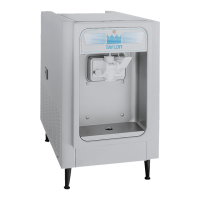23
Models 150, 152, 162, 168
Troubleshooting Guide
PROBLEM PROBABLE CAUSE REMEDY
6. Excessive leakage in rear drip
pan.
a. A worn or defective o-ring is on
the beater drive shaft.
a. Replace o-rings every 3 months.
b. The rear shell bearing is worn. b. Replace the rear shell bearing.
c. Incorrect lubricant was used. c. Use food grade lubric ant
(example: Taylor Lube).
d. Inadequate lubrication of beater
drive shaft.
d. Lubricate the beater drive s haft
properly.
7. The draw valve is leaking. a. Incorrect lubricant was used. a. Use food grade lubricant
(example: Taylor Lube).
b. Worn or defective o-rings are on
the draw valve.
b. Replace o-rings every 3 months.
c. Inadequate lubrication of draw
valve.
c. Lubricate the draw valve properly.
8. Product is not feeding into the
freezing cylinder.
a. The mix level is inadequate in the
mix hopper.
a. Fill the mix hopper with mix.
9. The unit goes out on overload
excessively.
a. There are too many appliances
plugged into the circuit.
a. A separate 20 amp. circuit is
needed for the freezer to operate
properly.
b. An extension cord has been
placed between the power cord
and the wall receptacle.
b. If the extension cord is used, it
must match the power cord in
size of circuit ampacity.
10. Models 162 and 168:
Mix from one freezing cylinder
bleeds over to the second
cylinder.
a. The center draw valve seal is
worn, or is improperly lubricated.
a. Lubricate properly and replace
seal every 3 months.
11. Compressor does not run. a. Control switc hes. a. Place switc hes in correct position
for compressor operation.
b. Fuse blown or circuit breaker. b. Replace fuse or turn breaker on.
c. Tripped overload. c. Allow to cool. Check for high head
pressure, tight bearings, stuck
pistons, c logged air cooled
condenser.
d. Compressor contactor in open
position.
d. Repair or replace the contactor.
e. Faulty capacitor relay. e. Replace the rela y.
12. Compressor will not start. Hums
intermittently. Cycling on
overload.
a. Improperly wired. a. Check wiring against diagram.
b. Low line voltage. b. Check main line voltage. Locate
the voltage drop.
c. Open starting capacitor. c. Replace the starting capacitor.
d. Faulty capacitor relay. d. Replace the rela y.

